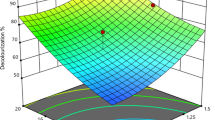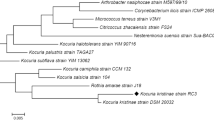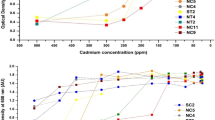Abstract
Textile effluents are hugely hazardous, and comparatively less research have been focused on their biodecolorization process optimization by single bacterium. Hence, present study was intended toward statistical optimization of textile wastewater biodecolorization by Pseudomonas sp. SUK1 employing response surface methodology. Effects of pH, temperature, and effluent concentrations were analyzed, and an optimal response of 92.20 % American Dye Manufacturing Institute (ADMI) value removal was recorded at 7.0 pH, 40 °C, and 40 % of effluent concentration. This response was maximized to 94.08 % ADMI removal from predicted solutions. Actual and predicted values were matching and the process was found suitable for quadratic model. Success of response surface methodology was validated from R 2. Significant interactions of each variable were demonstrated by response surface plots. Bacterium reduced the heavy metals concentration, Biological Oxygen Demand, and Chemical Oxygen Demand values significantly. Degradation of dyes was checked by high performance thin layer chromatography. Effluent treatment caused the nicking of pBR322. Up- /down- regulation of antioxidant enzymes in Allium cepa L. confirmed the severe toxicity of effluent and also suggested that the toxicity was significantly reduced by the bacterial treatment.






Similar content being viewed by others
References
Achary VM, Jena S, Panda KK, Panda BB (2008) Aluminium induced oxidative stress and DNA damage in root cells of Allium cepa L. Ecotoxicol Environ Saf 70:300–310
Aghamohammadi N, Aziz HBA, Isa MH, Zinatizadeh AA (2007) Powdered activated carbon augmented activated sludge process for treatment of semiaerobic landfill leachate using response surface methodology. Bioresour Technol 98:3570–3578
Ali H (2010) Biodegradation of synthetic dyes-a review. Water Air Soil Pollut 213:251–273
APHA (1998) Standard method for the examination of water and wastewater, 20th edn. American Public Health Association 2120 E, Washington
Ashraf M (2009) Biotechnological approach of improving plant salt tolerance using antioxidants as markers. Biotechnol Adv 27:84–93
Ayed L, Chaieb K, Cheref A, Bakhrouf A (2009) Biodegradation of triphenylmethane dye malachite green by Sphingomonas paucimobilis. World J Microbiol Biotechnol 25:705–711
Bhaskar M, Gnanamani A, Ganeshjeevan RJ, Chandrasekar R, Sadulla S, Radhakrishnan G (2003) Analyses of carcinogenic aromatic amines released from harmful azo colorants by Streptomyces sp. SS07. J Chromatogr 1018:117–123
Box GEP, Behnken DW (1960) Some new three level design for study of quantitative variables. Technometrics 2:455–475
Correia VM, Stephenson T, Judd SJ (1994) Characterization of textile wastewaters: a review. Environ Technol 15:917–919
Dey P, Sikder J, Roy S, Pal P (2012) Fermentative lactic acid production from a renewable carbon source under response surface optimized conditions without alkali addition: a membrane-based green approach. Clean Techn Environ Policy 14:827–835
Ferreira SLC, Burns RE, Ferreira HS, Matos GD, David JM, Brandao GC, da Silva EGP, Portugal LA, dos Reis PS, Souza AS, dos Santos WNL (2007) Box-Behnken design: alternative for the optimization of analytical methods. Anal Chim Acta 597:179–186
Forgacs E, Cserhati T, Oros G (2004) Removal of synthetic dyes from wastewaters: a review. Environ Int 30:953–971
Fu Y, Viraraghavan T (2001) Fungal decolorization of dye wastewaters: a review. Bioresour Technol 79:251–262
Hill WE, Perkins S, Sandlin GS (1993) Removal and speciation of transition metal ions textile dyeing wastewaters. Text Chem Color 25:26–27
Jadhav JP, Kalyani DC, Telke AA, Phugare SS, Govindwar SP (2010) Evaluation of the efficacy of a bacterial consortium for the removal of color, reduction of heavy metals, and toxicity from textile dye effluent. Bioresour Technol 101:165–173
Jadhav SB, Surwase SN, Phugare SS, Jadhav JP (2013) Response surface methodology mediated optimization of remazol orange decolorization in plain distilled water by Pseudomonas aeruginosa BCH. Int J Environ Sci Technol 10:181–190
Jalasutram V, Kataram S, Gandu B, Anupoju GR (2013) Single cell protein production from digested and undigested poultry litter by Candida utilis: optimization of process parameters using response surface methodology. Clean Techn Environ Policy 15:265–273
Kalyani DC, Patil PS, Jadhav JP, Govindwar SP (2008) Biodegradation of reactive textile dye Red BLI by an isolated bacterium Pseudomonas sp. SUK1. Bioresour Technol 99:4635–4641
Kalyani DC, Telke AA, Surwase SN, Jadhav SB, Lee JK, Jadhav JP (2012) Effectual decolorization and detoxification of triphenylmethane dye malachite green (MG) by Pseudomonas aeruginosa NCIM 2074 and its enzyme system. Clean Techn Environ Policy 14:989–1001
Kao CM, Chou MS, Fang WL, Liu BW, Huang BR (2001) Regulating colored textile wastewater by 3/31 wavelength ADMI methods in Taiwan. Chemosphere 44:1055–1063
Kousha M, Daneshvar E, Sohrabi MS, Koutahzadeh N, Khataee AR (2012) Optimization of C.I. Acid black 1 biosorption by Cystoseira indica and Gracilaria persica biomasses from aqueous solutions. Int Biodeterior Biodegradation 67:56–63
Kumar N, Bauddh B, Kumar S, Dwivedi N, Singh DP, Barman SC (2013) Extractability and phytotoxicity of heavy metals present in petrochemical industry sludge. Clean Techn Environ Policy 15:1033−1039
Kurade MB, Waghmode TR, Kagalkar AN, Govindwar SP (2012) Decolorization of textile industry effluent containing disperse dye scarlet RR by a newly developed bacterial-yeast consortium BL-GG. Chem Eng J 184:33–41
Lin D, Xing B (2007) Phytotoxicity of nanoparticles: Inhibition of seed germination and root growth. Environ Pollut 150:243–250
Maguire RJ (1992) Occurrence and persistence of dyes in a Canadian river. Water Sci Technol 25:265–270
Neoh CH, Yahya A, Adnan R, Majid ZA, Ibrahim Z (2013) Optimization of decolorization of palm oil mill effluent (POME) by growing cultures of Aspergillus fumigatus using response surface methodology. Environ Sci Pollut Res 20:2912–2923
Nyanhongo GS, Gomesa J, Gubitz GM, Zvauya R, Readd J, Steiner W (2002) Decolorization of textile dyes by laccases from a newly isolated strain of Trametes modesta. Water Res 36:1449–1456
Pereira L, Coelho AV, Viegas CA, Correia dos Santos MM, Robalo MP, Martins LO (2009) Enzymatic biotransformation of the azo dye sudan orange G with bacterial CotA-laccase. J Biotechnol 139:68–77
Phugare SS, Kalyani DC, Surwase SN, Jadhav JP (2011) Ecofriendly degradation, decolorization and detoxification of textile effluent by a developed bacterial consortium. Ecotoxicol Environ Saf 74:1288–1296
Robinson T, McMullan G, Marchant R, Nigam P (2001) Remediation of dyes in textile effluent: a critical review on current treatment technologies with a proposed alternative. Bioresour Technol 77:247–255
Rybicki E, Swiech T, Lesniewska E, Albinska J, Szynkowska MI, Paryjczak T, Sypniewski S (2004) Changes in hazardous substances in cotton after mechanical and chemical treatments of textiles. Fibres Text East Eur 12:67–73
Selvam K, Swaminathan K, Keo-Sang C (2003) Microbial decolorization of azo dyes and dye industry effluent by Fomes lividus. World J Microbiol Biotechnol 19:591–593
Sharma P, Singha L, Dilbaghi N (2009) Response surface methodological approach for the decolorization of simulated dye effluent using Aspergillus fumigatus Fresenius. J Hazard Mater 161:1081–1086
Siddiqui AH, Tabrez S, Ahmad M (2011) Short-term in vitro and in vivo genotoxicity testing systems for some water bodies of Northern India. Environ Monit Assess 180:87–95
Stiborova M, Martinek V, Rydlova H, Hodek P, Frei E (2002) Sudan I is a potential carcinogen for humans: evidence for its metabolic activation and detoxication by human recombinant cytochrome P450 1A1 and liver microsomes. Cancer Res 62:5678–5684
Tabreza S, Ahmad M (2011) Oxidative stress-mediated genotoxicity of wastewaters collected from two different stations in northern India. Mutat Res 726:15–20
Taran M, Sharifi M, Bagheri S (2011) Utilization of textile wastewater as carbon source by newly isolated Haloarcula sp. IRU1: optimization of conditions by Taguchi methodology. Clean Techn Environ Policy 13:535–538
Tavares AP, Cristóvão RO, Loureiro JM, Boaventura RA, Macedo EA (2009) Application of statistical experimental methodology to optimize reactive dye decolourization by commercial laccase. J Hazard Mater 162:1255–1260
Vedaraman N, Begum SS, Srinivasan SV (2013) Response surface methodology for decolourisation of leather dye using ozonation in a packed bed reactor. Clean Techn Environ Policy 15:607–616
Yann D, Didier H, Daniel B (2005) Utilisation of the experimental design methodology to reduce browning defects in hard cheeses technology. J Food Eng 68:481–490
Zhang T, Wen S, Tan T (2007) Optimization of the medium for glutathione production in Saccharomyces cerevisiae. Process Biochem 42:454–458
Author information
Authors and Affiliations
Corresponding author
Rights and permissions
About this article
Cite this article
Jadhav, S.B., Chougule, A.S., Shah, D.P. et al. Application of response surface methodology for the optimization of textile effluent biodecolorization and its toxicity perspectives using plant toxicity, plasmid nicking assays. Clean Techn Environ Policy 17, 709–720 (2015). https://doi.org/10.1007/s10098-014-0827-3
Received:
Accepted:
Published:
Issue Date:
DOI: https://doi.org/10.1007/s10098-014-0827-3




